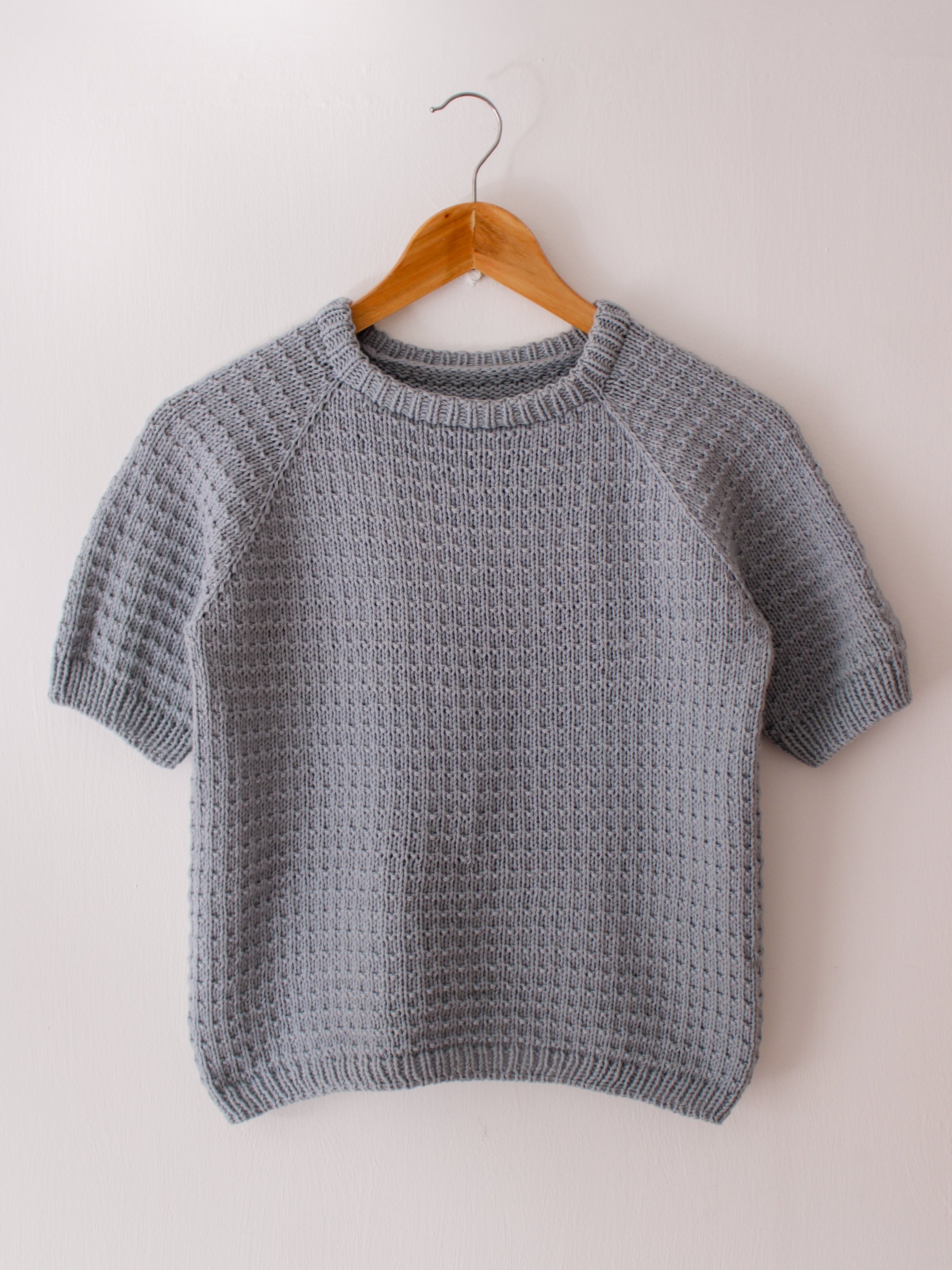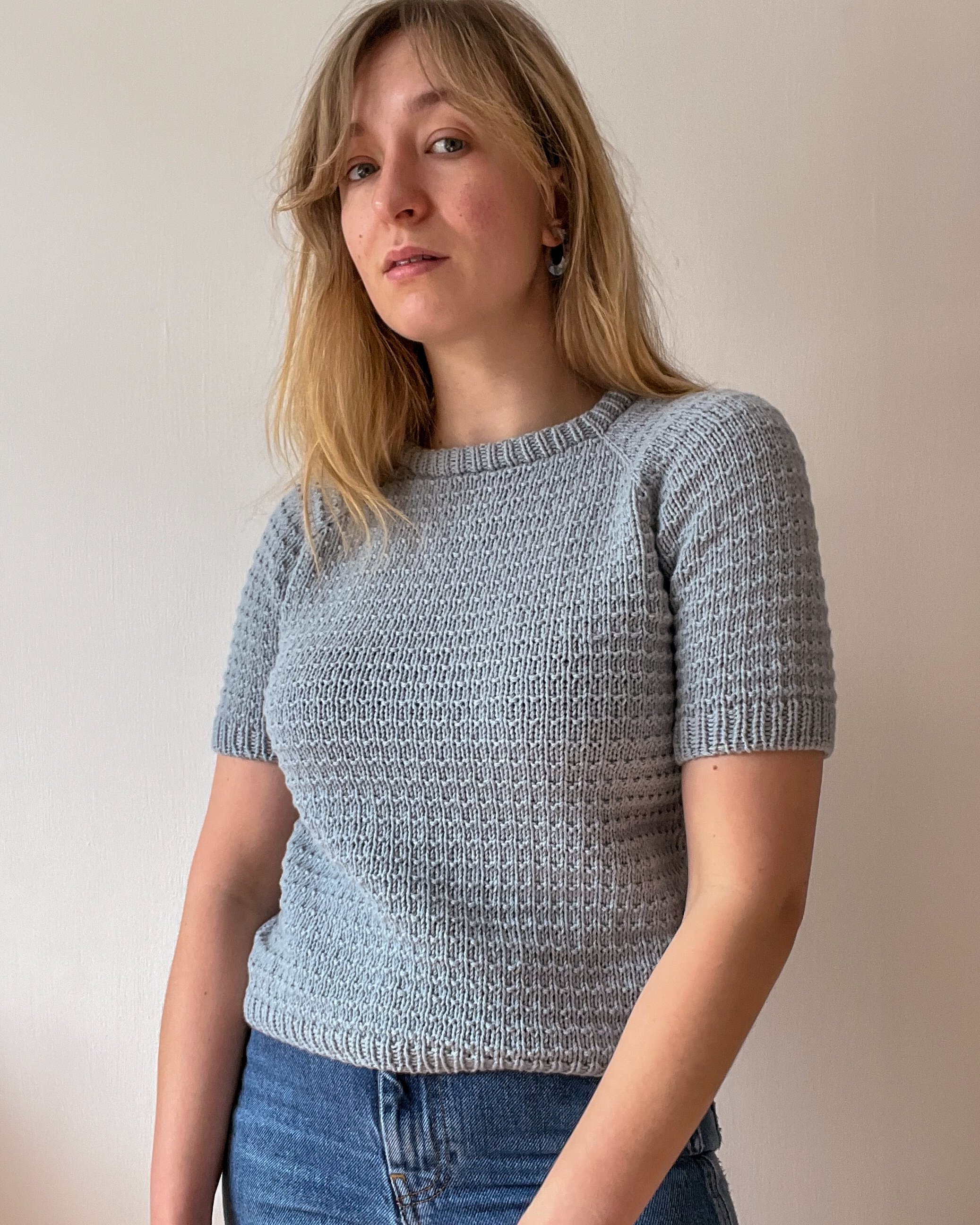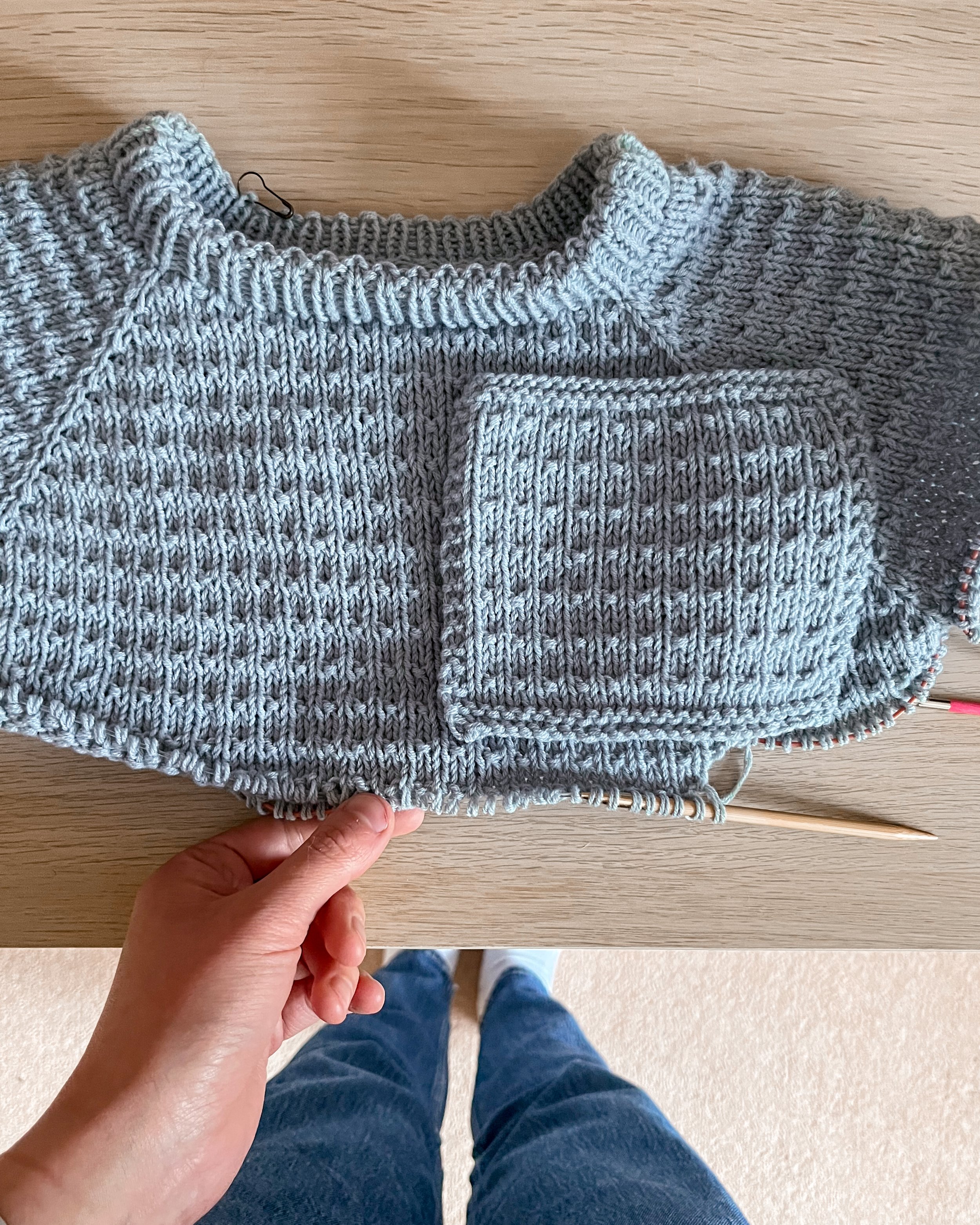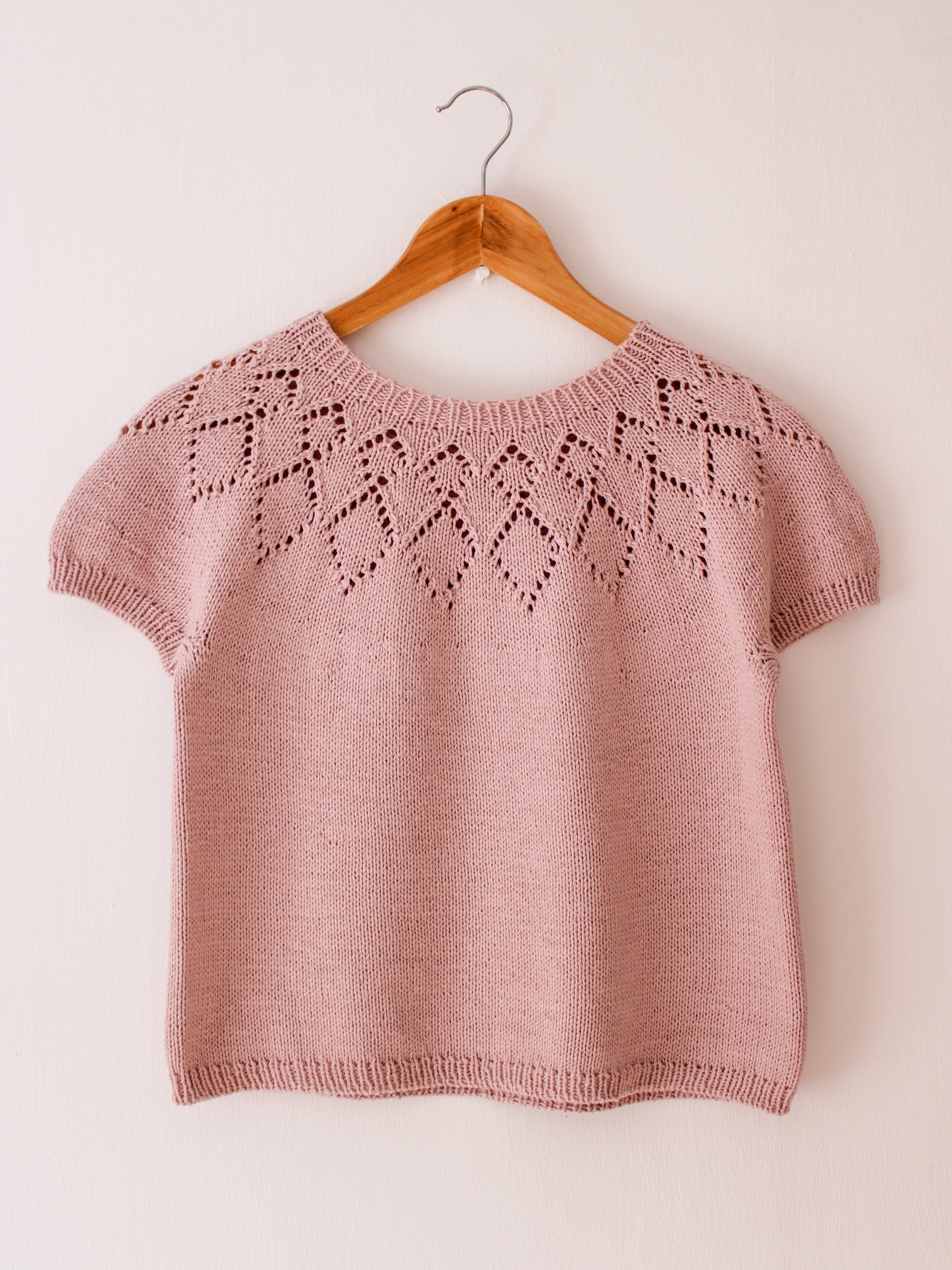Aosta Summer Top 2.0
The Aosta Summer Top is a raglan t-shirt with a lovely all-over Andalusian stitch texture, worked top-down and in the round. You will begin with the yoke and then move on to some short-row shaping across the back and shoulders to give the neckline a round effect. You will then work raglan shaping, with compound increases. When the yoke shaping is done, you will leave the sleeve stitches to rest and work the body. Next, you will apply the collar before finishing by working each sleeve with some light shaping.
Please note that this is a pdf digital download and not a physical knitting pattern.
The Aosta Summer Top is a raglan t-shirt with a lovely all-over Andalusian stitch texture, worked top-down and in the round. You will begin with the yoke and then move on to some short-row shaping across the back and shoulders to give the neckline a round effect. You will then work raglan shaping, with compound increases. When the yoke shaping is done, you will leave the sleeve stitches to rest and work the body. Next, you will apply the collar before finishing by working each sleeve with some light shaping.
Please note that this is a pdf digital download and not a physical knitting pattern.
The Aosta Summer Top is a raglan t-shirt with a lovely all-over Andalusian stitch texture, worked top-down and in the round. You will begin with the yoke and then move on to some short-row shaping across the back and shoulders to give the neckline a round effect. You will then work raglan shaping, with compound increases. When the yoke shaping is done, you will leave the sleeve stitches to rest and work the body. Next, you will apply the collar before finishing by working each sleeve with some light shaping.
Please note that this is a pdf digital download and not a physical knitting pattern.
Materials & Fit
Notions: You will need 3 mm [US 2.5] (40-cm [16-in] cord) and 4 mm [US 6] (40-, 60-, and/or a 80-/100-cm [16-, 24-, and/or a 32-/40-in cord], 5 mm [US 8] (40-, 60-, and/or a 80-/100-cm [16-, 24-, and/or a 32-/40-in cord] circular needles. You will also need at least 8 stitch markers, one of which should be in a contrasting colour to indicate the beginning of the round, a darning needle, and either scrap yarn, spare circular needles, or stitch holders for the resting sleeve stitches.
Tension: 18 stitches x 28 rows/rounds in Andalusian stitch on 5 mm [US 8] = 10 x 10 cm [4 x 4 in]. Row gauge shouldn’t be too important for this project, but it may pose some issues for the yoke depth for the larger sizes if yours is significantly looser than mine. You may wish to omit some of the plain rounds with no increases towards the end of the yoke; please email me if you need guidance with this.
Please note that if you are using a plant-based yarn (e.g., King Cole Bamboo Cotton, more on which below), you may need to go down at least half a needle size.
Yarn: I estimate that you will need approximately 1,070 (1,150) 1,240 (1,325), 1,420 (1,520) 1,600 (1,700), 1,830 (1,970) 2,180 (2,360) m [1,170 (1,260) 1,360 (1,450), 1,560 (1,670) 1,750 (1,860), 2,010 (2,160) 2,390 (2,590) yds] of a fingering-weight yarn held double.
I have tried to be generous here, and these estimates are based on the quantity of yarn used to make the sample garment. To help with clarity, I have also rounded the quantities to the nearest 10 m and converted these figures into yards, which I have then rounded to the nearest 10 yards.
For my sample garment, I used Knitting for Olive Merino (50 g = 250 m [274 yds]; 100% merino wool) held double, in the shade Soft Blue.
If you wanted to use the same yarn, this works out to be 5 (5) 5-6 (6), 7 (7) 7 (7), 8 (8) 9 (10) balls of Knitting for Olive Merino.
Yarn alternatives: Any fingering-weight merino wool held double would be lovely here as an alternative. Sandnes Garn Sunday (50 g = 235 m [257 yds]; 100% merino wool) is a great alternative. I’d recommend sticking with non-superwash merino wools for best results.
Two strands of a fingering-weight cotton-merino blend wool, like Knitting for Olive Cotton Merino (50 g = 250 m [274 yds]; 70% merino wool, 30% cotton) or Gepard CottonWool 3 (50 g = 230 m [252 yds]; 50% cotton, 50% merino) would also be a great, warm-weather friendly option.
You could also use one strand of fingering-weight yarn with a strand of lace- weight yarn, like a lace-weight silk mohair, for a fluffier finish.
Another good option would be to use a strand of a plant-based yarn like Isager Trio 2 (50 g = 175 m [191 yds]; 50% linen, 30% cotton, 20% lyocell) or Isager Bomulin (50 g = 210 m [230 yds]; 65% cotton and 35% linen) along with a strand of merino wool.
You could also use a light DK-weight yarn held single for this pattern. I estimate that you would then need 540 (580) 620 (670), 710 (760) 800 (850), 920 (990) 1,090 (1,180) m [590 (640) 680 (740), 780 (840) 880 (930), 1,010 (1,090) 1,200 (1,290) yds].
A good example here would be King Cole Bamboo Cotton (100 g = 230 m [252 yds]; 50% bamboo viscose, 50% cotton). You’d get a really lovely, cooling fabric with this yarn as it is entirely plant-based, but I would recommend checking your gauge carefully and possibly going down a needle size. My row gauge is the same with this yarn, but my stitch gauge with the same 5 mm [US 8] needles was only 17 stitches in 10 x 10 cm [4 x 4 in] of Andalusian stitch, as opposed to 18. This doesn’t sound like much, but the cumulative effect could have a significant effect on the fit of the final garment – especially if you are making a larger size.
Sandnes Garn Duo (50 g = 115 m [126 yds]; 55% merino wool, 45% cotton) is another lovely option.
Sizing and ease: The Aosta Summer Top has recommended neutral ease, between 3.5 cm [1.5 in] positive ease and 3.5 cm [1.5 in] negative ease for Sizes A-H, and between 5 cm [2 in] positive ease and 5 cm [2 in] negative ease for Sizes I-L around the chest. If you would prefer more ease, pick a size up. If you would prefer less ease, pick a size down. Use the schematic below to find your best size based on your chest measurement.
Size: A (B) C (D), E (F) G (H), I (J) K (L)
Chest measurement (cm): 75-80 (80-85) 85-90 (90-95), 95-100 (100-105) 105-110 (110-115), 115-125 (125-135) 135-145 (145-155)
Chest measurement (in): 29.5-31.5 (31.5-33.5) 33.5-35.5 (35.5-37.5), 37.5-39.25 (39.25-41.25) 41.25-43.25 (43.25-45.25), 45.25-49.25 (49.25-53.25) 53.25-57 (57-61)
Actual circumference of garment (cm): 78 (82.5) 86.5 (93.5), 98 (102.5) 106.5 (111), 120 (129) 140 (149)
Actual circumference of garment (in): 30.75 (32.5) 34 (36.75), 38.5 (40.25) 42 (43.75), 47.25 (50.75) 55.25 (58.75)
Approximate yoke depth (cm): 18 (18) 18.5 (19.5), 19.5 (21) 21.5 (22.5), 22.5 (23) 23.5 (24.5)
Approximate yoke depth (in): 7 (7) 7.25 (7.75), 7.75 (8.25) 8.5 (8.75), 8.75 (9) 9.25 9.75)
Recommended total length, from cast-on edge to hem at centre-back (cm): 47 (48.5) 50 (51.5), 53 (54.5) 56 (57.5), 59 (60.5) 62 (63.5)
Recommended total length, from cast-on edge to hem at centre-back (in): 18.5 (19) 19.75 (20.25), 20.75 (21.5) 22 (22.5), 23.25 (23.75) 24.5 (25)
Sleeve circumference (cm): 28 (29) 31.5 (32.5), 34.5 (34.5) 35.5 (37), 40 (44.5) 48 (52.5)
Sleeve circumference (in): 11 (11.5) 12.5 (12.75), 13.5 (13.5) 14 (14.5), 15.75 (17.5) 19 (20.75)
Recommended sleeve length (from underarm to cuff, cm): 12
Recommended sleeve length (from underarm to cuff, in): 4.75
These measurements have been rounded to the nearest 0.5 cm and 0.25 in. The sample garments are both Size D to fit a chest measurement of 92 cm [36 in].
Techniques include leaning increases and decreases, German short rows, working in the round, picking up stitches along a cast-on edge, and tubular cast-offs.












